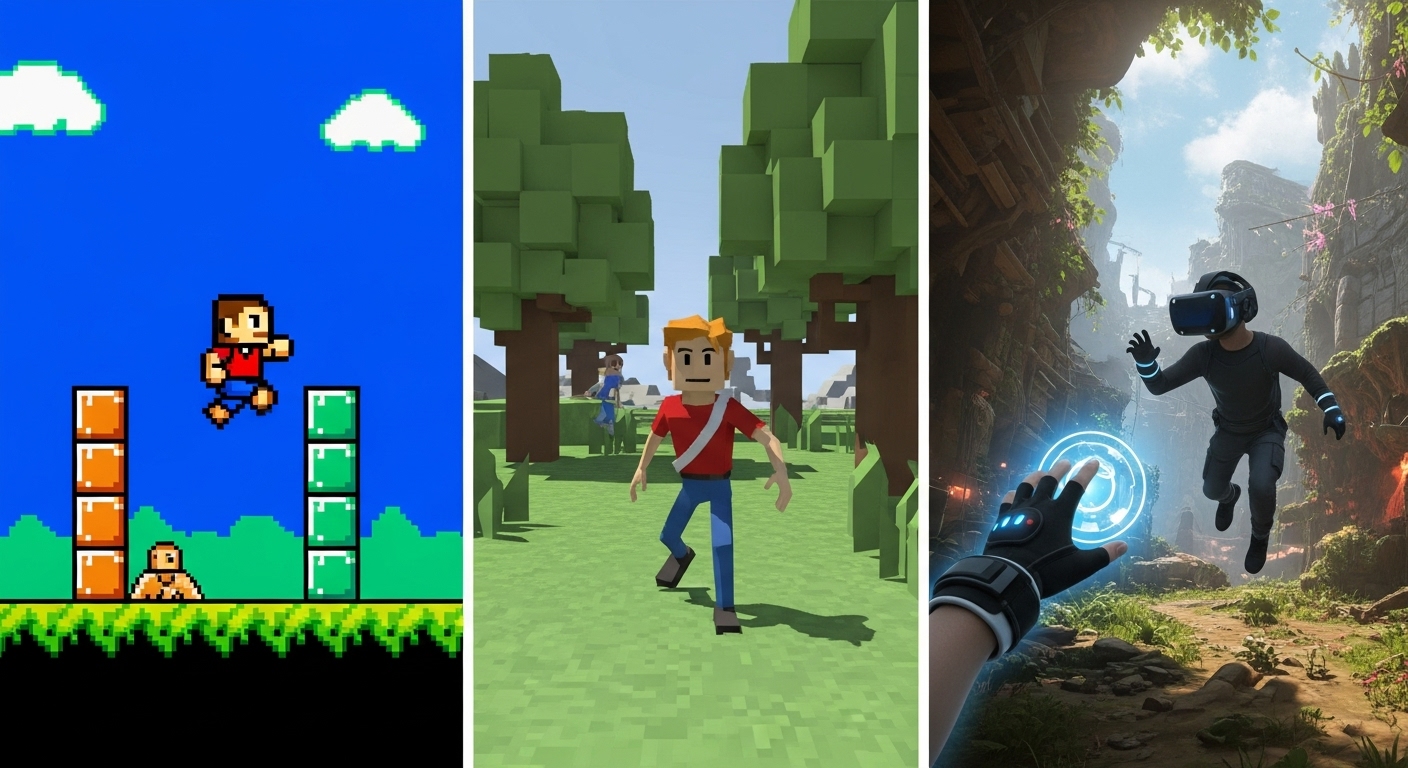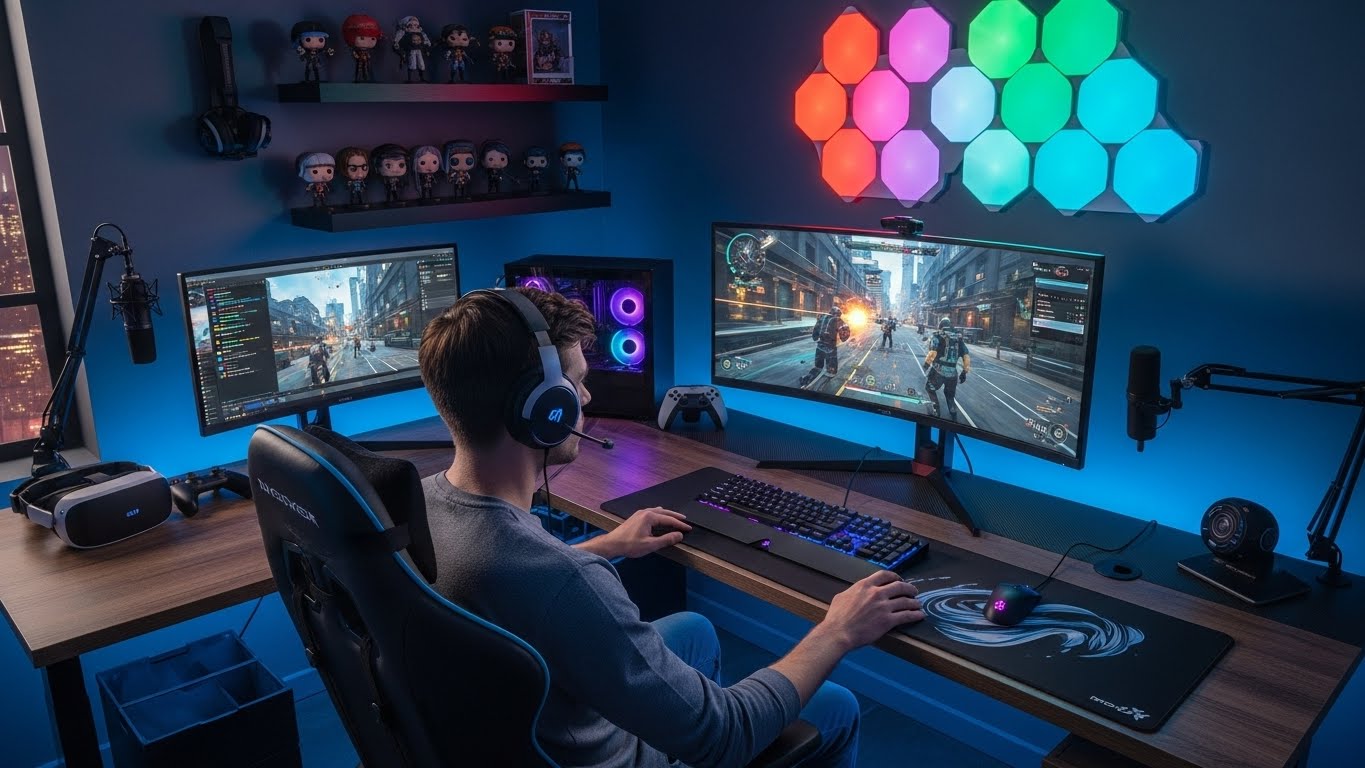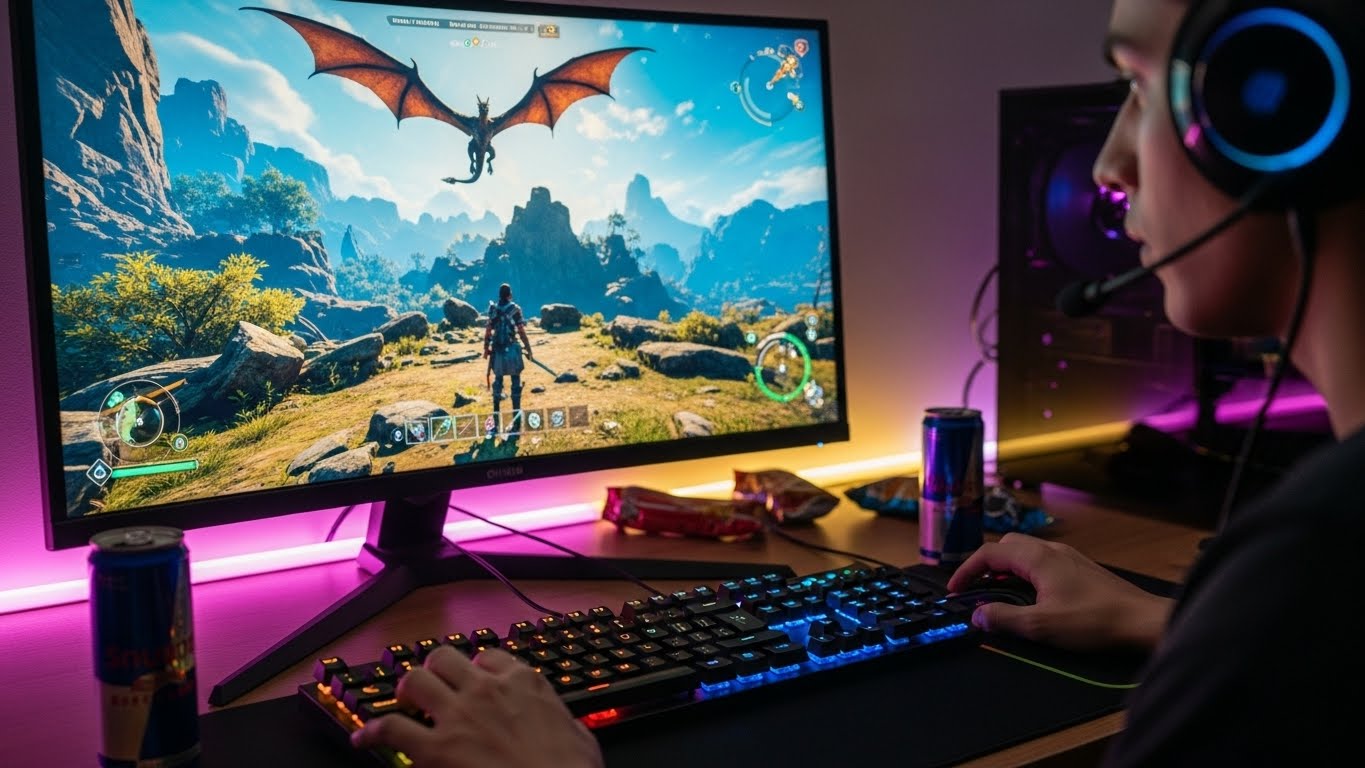Introduction
Gaming has transformed from a niche hobby into one of the most powerful entertainment industries in the world. What once began as simple lines of code creating bouncing dots on monochrome screens has become a multibillion-dollar global phenomenon that shapes culture, drives technology, and connects people across continents. The story of gaming is one of creativity, innovation, and passion. It’s a story about how play has evolved into art, sport, and storytelling medium.
In this article, we will explore the fascinating journey of gaming—from its early roots to its modern-day sophistication—examining how it has changed technology, society, and the way we think about fun and connection.
The Birth of Video Games
The origins of gaming can be traced back to the 1950s when computer scientists began experimenting with interactive programs for research and recreation. One of the earliest examples was “Tennis for Two,” created in 1958 by physicist William Higinbotham. This simple game simulated tennis on an oscilloscope screen, sparking curiosity about the potential of computers beyond pure calculation.
In the 1970s, video games took their first steps into the public domain. Arcade machines like Pong, developed by Atari, brought gaming to the masses. People lined up in arcades and bars to experience something entirely new: the ability to interact with a screen and compete against friends or strangers. These were simple games, with primitive graphics and sounds, yet they carried an irresistible sense of novelty and excitement.
This period marked the birth of the gaming industry, setting the stage for decades of innovation to come.
The Rise of Consoles
The 1980s were the golden age of gaming consoles. Nintendo, Sega, and Atari became household names as they introduced gaming into living rooms around the world. Titles like Super Mario Bros., The Legend of Zelda, and Sonic the Hedgehog not only defined a generation but also laid the foundations for what gaming could achieve in terms of creativity and storytelling.
The home console changed everything. Families no longer needed to visit arcades; they could enjoy high-quality games from the comfort of their homes. The concept of gaming as a family activity began to take hold. Nintendo, in particular, revolutionized the industry by emphasizing accessible fun over complexity, creating characters and worlds that appealed to all ages.
During this time, gaming also began to develop its culture. Magazines, television shows, and even early fan communities started to appear. The idea of gamers as a distinct social group was born.
The 16-Bit Revolution
By the late 1980s and early 1990s, gaming technology took another major leap forward. The 16-bit era brought richer graphics, more detailed worlds, and improved soundtracks. The competition between Sega’s Genesis and Nintendo’s Super NES defined this era. Players debated endlessly over which console had better games or faster performance, creating one of the earliest “console wars.”
This period also gave birth to some of the most beloved franchises in gaming history. Games like Final Fantasy VI, Chrono Trigger, and Street Fighter II showed that games could offer not just entertainment but also emotional depth and artistic expression. Developers experimented with storytelling, creating worlds that players could explore, empathize with, and remember long after turning off their systems.
The 16-bit revolution also influenced future generations of developers. Many modern designers cite these games as their inspiration to pursue careers in game creation, a testament to how powerful this era’s influence remains.
The Move to 3D and the Birth of Modern Gaming
The mid-1990s marked a dramatic shift from two-dimensional sprites to fully three-dimensional environments. The introduction of consoles like the PlayStation, Nintendo 64, and Sega Saturn changed the visual and interactive possibilities of gaming. Suddenly, players could move freely in three-dimensional spaces, opening up endless creative opportunities.
Games such as Super Mario 64 and The Legend of Zelda: Ocarina of Time redefined what it meant to play. They provided a sense of freedom and immersion that had never been possible before. The 3D era also introduced cinematic storytelling. Games began incorporating voice acting, elaborate cutscenes, and intricate plots that rivaled films in emotional impact.
This era also saw the birth of new genres—first-person shooters, 3D fighting games, and expansive role-playing titles—that continue to dominate the market today. Developers pushed technology to its limits, striving to create more lifelike animations, smoother gameplay, and more believable worlds.
The Online Revolution
The early 2000s brought another transformative wave: the rise of online gaming. As internet connections became faster and more accessible, players could now connect and compete with others around the globe. Multiplayer experiences evolved from split-screen gaming to massive online ecosystems.
Titles like Counter-Strike, World of Warcraft, and Halo 2 redefined social interaction in gaming. Online platforms became digital meeting places where friendships were formed and rivalries flourished. Gaming was no longer a solitary activity—it was a shared experience that crossed borders and time zones.
The online revolution also gave rise to digital distribution. Platforms began offering downloadable games, removing the need for physical discs. This shift empowered independent developers to reach audiences directly, sparking a renaissance in creativity and innovation.
The Rise of Indie Games
As technology became more accessible, small teams and even individual creators began developing their own games without the backing of major studios. Indie gaming exploded in the late 2000s and early 2010s, introducing fresh perspectives and experimental mechanics that challenged the status quo.
Games like Minecraft, Undertale, and Celeste demonstrated that success didn’t depend on massive budgets or realistic graphics. Instead, creativity, emotional depth, and unique gameplay experiences became the driving forces behind many of these indie hits.
Indie developers often tackled personal or unconventional themes, expanding gaming’s cultural and artistic boundaries. The rise of digital marketplaces gave them a platform to reach millions, proving that the heart of gaming lies not just in technology but in human imagination.
Gaming as an Art Form
The ongoing debate over whether video games can be considered art has long been settled by the sheer range of creative expression in modern titles. Games today tell complex stories, evoke powerful emotions, and explore philosophical ideas just as effectively as films or literature.
Titles like The Last of Us, Journey, and Red Dead Redemption 2 blend narrative, visual design, music, and interactivity into experiences that rival great works of art. Players don’t just watch stories—they participate in them, shaping outcomes through their actions. This interactive element gives gaming a unique power to engage emotions and intellect simultaneously.
Game designers have become the new storytellers, using digital tools to explore human nature, ethics, and society. The artistry of gaming now extends to every aspect—visuals, writing, sound design, and even gameplay mechanics themselves.
The Emergence of Esports
Another major shift in gaming’s history came with the rise of competitive gaming, or esports. What began as small tournaments among friends has grown into a global industry with professional teams, sponsorships, and massive audiences.
Games like League of Legends, Dota 2, and Counter-Strike: Global Offensive have turned competition into spectacle, filling arenas and attracting millions of viewers online. Esports athletes train for hours, develop strategies, and perform under pressure just like traditional sports professionals.
Esports also changed perceptions of gaming. No longer dismissed as a casual pastime, gaming became recognized as a legitimate form of skill and discipline. Universities began offering scholarships, broadcasters signed streaming deals, and fans developed the same passion for their favorite teams as football or basketball enthusiasts.
The Role of Streaming and Content Creation
In recent years, streaming platforms have transformed how people engage with games. Platforms like Twitch and YouTube Gaming have made it possible for anyone to broadcast their gameplay and build communities around shared interests.
This shift has turned gamers into entertainers and influencers. Millions tune in daily to watch their favorite streamers play, comment, and connect with audiences in real time. This new ecosystem has created entire careers out of gaming—something unimaginable just two decades ago.
Streaming has also made gaming more inclusive. Viewers can learn, laugh, and participate without needing to play themselves. It has democratized gaming culture, allowing diverse voices and personalities to flourish.
The Power of Community
At the heart of gaming lies community. Whether through online clans, local co-op sessions, or fan conventions, gaming brings people together. It bridges cultural and linguistic gaps, creating a shared language of fun and creativity.
Communities don’t just play together—they create together. Fan art, mods, forums, and conventions like gaming expos all contribute to a vibrant ecosystem of collaboration. Many developers even rely on community feedback to refine and improve their games.
This collaborative spirit has also made gaming a force for social good. Charity streams, awareness campaigns, and community-driven projects demonstrate the positive potential of gamers united by common goals.
The Evolution of Technology
The relentless advancement of technology has fueled gaming’s growth at every stage. From the first 8-bit consoles to today’s ultra-realistic graphics, innovation has always been the engine of progress.
Modern gaming harnesses cutting-edge tools like artificial intelligence, real-time ray tracing, and motion capture to create experiences once thought impossible. Virtual and augmented reality are pushing the boundaries of immersion even further, allowing players to step inside their favorite worlds.
Cloud gaming is also emerging as a major force, enabling high-end gaming experiences on any device with an internet connection. This shift could reshape the industry, making games more accessible than ever.
Technology not only improves visuals but also enhances storytelling and interaction. Artificial intelligence-driven characters can now respond dynamically to player choices, creating a sense of authenticity and unpredictability.
Gaming and Mental Health
While gaming has often been criticized for promoting isolation or addiction, research increasingly shows its potential benefits for mental health. Games can serve as stress relievers, creative outlets, and even therapeutic tools.
Interactive storytelling can help players process emotions, while multiplayer games provide social connections that combat loneliness. Certain games are even being used in clinical settings to help treat anxiety, depression, and cognitive disorders.
Of course, balance remains essential. Like any form of entertainment, moderation ensures that gaming remains positive and fulfilling rather than overwhelming.
Representation and Diversity in Gaming
The gaming industry has made significant strides in recent years toward greater inclusivity and representation. Modern games now feature diverse characters, cultures, and narratives that reflect the world’s richness.
Developers are more conscious of portraying stories that resonate with broader audiences. Female protagonists, LGBTQ+ representation, and culturally authentic settings are becoming more common. This inclusivity not only enriches storytelling but also ensures that everyone can see themselves reflected in the games they play.
Representation extends beyond characters to developers themselves. More diverse voices in the industry mean more perspectives and creativity in game design, leading to more meaningful and varied experiences for players.
The Future of Gaming
Looking ahead, gaming’s future is boundless. Artificial intelligence, cloud computing, virtual reality, and augmented reality are converging to redefine what games can be. Players may soon experience worlds indistinguishable from reality, guided by intelligent systems that adapt to their choices and emotions.
The rise of cross-platform gaming and the blending of physical and digital experiences will make gaming more connected than ever. Meanwhile, advances in accessibility will ensure that anyone, regardless of ability or device, can participate fully.
The future also promises deeper integration of gaming with other aspects of life—education, fitness, art, and social interaction. As technology continues to evolve, gaming will remain at the forefront of innovation and imagination.
Conclusion
From the blinking pixels of the past to the breathtaking realism of today, gaming has traveled an extraordinary path. It has grown from a curiosity into a global cultural powerhouse that influences art, technology, and society. More than just entertainment, gaming is a reflection of human creativity—a medium through which we explore worlds, tell stories, and connect with others.
Every generation of gamers builds upon the last, carrying forward the spirit of play that lies at the heart of the experience. The evolution of gaming is far from over. As long as humans seek adventure, challenge, and connection, gaming will continue to evolve, inspiring us to dream, create, and play without limits.



